Central Kalimantan
Central Kalimantan
Kalimantan Tengah | |
|---|---|
| Province of Central Kalimantan Provinsi Kalimantan Tengah | |
| Nickname: Bumi Tambun Bungai | |
| Motto(s): Isen Mulang (Ngaju) Persistent | |
 | |
| Coordinates: 2°13′S 113°55′E / 2.217°S 113.917°E | |
| Founded | 2 July 1958 |
| Capital and largest city | Palangka Raya |
| Government | |
| • Body | Central Kalimantan Provincial Government |
| • Governor | Sugianto Sabran (PDI-P) |
| • Vice Governor | Edy Pratowo |
| Area | |
• Total | 153,443.91 km2 (59,245.02 sq mi) |
| • Rank | 1st |
| Highest elevation (Bukit Raya) | 2,300 m (7,546 ft) |
| Population (mid 2024 Estimate)[1] | |
• Total | 2,809,700 |
| • Density | 18/km2 (47/sq mi) |
| Demographics | |
| • Ethnic groups | 46% Dayak 22% Javanese 21% Banjarese 3.9% Malay 1.9% Madurese 4.8% other[3] |
| • Religion (2021)[4] | 74.11% Islam 16.67% Protestant 5.84% Hinduism/Kaharingan 3.23% Catholic 0.11% Buddhism 0.1% other[4][5] |
| • Languages | Indonesian (official) Ngaju Banjar Maanyan |
| Time zone | UTC+7 (Western Indonesian Time) |
| GDP (nominal) | 2022 |
| - Total[6] | Rp 199.9 trillion (21st) US$ 13.5 billion Int$ 42.0 billion (PPP) |
| - Per capita[7] | Rp 72.9 million (9th) US$ 4,913 Int$ 15,329 (PPP) |
| - Growth[8] | |
| HDI (2024) | |
| Website | kalteng.go.id |
Central Kalimantan (Indonesian: Kalimantan Tengah) is a province of Indonesia. It is one of five provinces in Kalimantan, the Indonesian part of Borneo. It is bordered by West Kalimantan to the west, South Kalimantan and East Kalimantan to the east, Java Sea to the south and is separated narrowly from North Kalimantan and Malaysia by East Kalimantan's Mahakam Ulu Regency. Its provincial capital is Palangka Raya and in 2010 its population was over 2.2 million,[10] while the 2020 Census showed a total of almost 2.67 million;[11] the official estimate as at mid 2023 was 2,774,747 (comprising 1,434,119 males and 1,339,628 females), and was projected to rise to 2,809,700 at mid 2024.[1]
The population growth rate was almost 3.0% per annum between 1990 and 2000, one of the highest provincial growth rates in Indonesia during that time; in the subsequent decade to 2010 the average annual growth rate slowed markedly to around 1.8%, but it rose again in the decade beginning 2010. More than is the case in other province in the region, Central Kalimantan is populated by the Dayaks, the indigenous inhabitants of Borneo.
History
[edit]Since the eighteenth century the central region of Kalimantan and its Dayak inhabitants were ruled by the Muslim Sultanate of Banjar. Following Indonesian independence after World War II, Dayak tribes demanded a province separate from South Kalimantan province.[12]
In 1957 South Kalimantan was divided to provide the Dayak population with greater autonomy from the Muslim population in the province. The change was approved by the Indonesian Government on 23 May 1957 under Presidential Law No. 10 Year 1957, which declared Central Kalimantan the seventeenth province of Indonesia. President Sukarno appointed the Dayak-born national hero Tjilik Riwut as the first Governor and Palangkaraya the provincial capital.[13]
Geography
[edit]Central Kalimantan is the largest Indonesian province by area (Papua held this position until the 2022 partition) with a size of 153,443.91 km2 (59,245.02 sq mi), about 1.5 times the size of the island of Java and it is slightly larger than Bangladesh or the U.S. state of Illinois. It is bordered by West Kalimantan and East Kalimantan provinces to the north, by the Java Sea to the south, by South Kalimantan and East Kalimantan provinces to the east, and by West Kalimantan province to west.
The Schwaner Mountains stretch from the north-east of the province to the south-west, 80% of which is covered in dense forest, peatland swamps, mangroves, rivers and traditional agriculture land. Highland areas in the north-east are remote and not easily accessible. Non-volcanic mounts are scattered in this area including Kengkabang, Samiajang, Liang Pahang and Ulu Gedang.
The centre of the province is covered with tropical forest, which produces rattan, resin and valuable timber such as Ulin and Meranti. The southern lowlands are dominated by peatland swamps that intersect with many rivers. Sabangau National Park is a protected peatland area internationally acknowledged as sanctuary for the endangered Orangutan. Recently the peat swamp forests have been damaged by the Mega Rice Project, which unsuccessfully sought to turn large areas into rice paddies.
The province's climate is wet weather equatorial zone with an eight-month rainy season, and 4 months of dry season. Rainfall or precipitation is 2,776—3,393 mm per year with an average of 145 rainy days annually.[citation needed]
Rivers
[edit]Central Kalimantan has numerous rivers from the catchment areas to the north in the Schwaner Mountains, flowing to the Java Sea. The major rivers include:
- Barito River (900 km)
- Kapuas River (600 km)
- Kahayan River (600 km)
- Katingan River (600 km)
- Mentaya (Sampit) River (400 km)
- Seruyan River (350 km)
- Lamandau River (300 km)
- Arut River (250 km)
- Sabangau River (200 km)
- Kumai River (179 km)
- Jelai River (100 km)
Rivers are an important mode of transportation and a primary location for settlement. With relatively undeveloped infrastructure, the province's economy relies heavily on the rivers.[citation needed]
Ecology
[edit]Based upon the research of the Indonesian Ministry of Environment and Forestry, Central Kalimantan has approximately 10 different ecological regions and is dominated by two main ecological regions. Those two are peat ecological region which covered 26% of the total area of Central Kalimantan and the fluvial plain ecoregion which covered 21% of the whole area of Central Kalimantan.[14] Due to its high concentration of peat ecological region, Central Kalimantan is prone to drought and peat fires during the dry season and inundation during the rainy season within each episodes of the ENSO and the IOD. These situations worsen because of massive deforestation in the region and climate change.
Central Kalimantan is also home for many endemic floras and faunas like orangutans, proboscis monkeys, hornbill birds, rattan, Bornean iron wood, etc. This province currently has three national parks i.e. Sabangau National Park, Tanjung Puting National Park, and Bukit Baka Bukit Raya National Park which are home to the endemic floras and faunas of Kalimantan.[14]
Government and administrative divisions
[edit]Central Kalimantan Province, when separated from South Kalimantan in 1958, comprised three regencies (kabupaten) - Barito, Kapuas and Kotawaringin. However on 26 June 1959 two of these were split - Barito Regency was divided into a South Barito Regency and a North Barito Regency, while Kotawaringin Regency was divided into a West Kotawaringin Regency and an East Kotawaringin Regency. On 14 June 1965 the provincial capital of Palangka Raya was split off from Kapuas Regency to form an independent city (kotamadya).
On 10 April 2002 an additional eight regencies were created by splitting existing regencies - Sukamara and Lamandau from parts of West Kotawaringin Regency, Seruyan and Katingan from parts of East Kotawaringin Regency, Pulang Pisau and Gunung Mas from parts of Kapuas Regency, East Barito from part of South Barito Regency, and Murung Raya from part of North Barito Regency. Thus the province now is administratively divided into thirteen regencies (each headed by a regent) and the single city. These are listed below with their areas and their populations at the 2010[10] and 2020[11] Censuses, together with the official estimates as at mid 2023.[1]
| Kode Wilayah |
Name of City or Regency |
Area in km2 |
Pop'n 2000 Census |
Pop'n 2010 Census |
Pop'n 2020 Census |
Pop'n mid 2023 Estimate |
Capital | HDI[15] 2022 |
Location Map |
|---|---|---|---|---|---|---|---|---|---|
| 62.01 | West Kotawaringin Regency (Kotawaringin Barat) |
9,480.3 | 168,472 | 235,803 | 270,388 | 279,740 | Pangkalan Bun | 0.734 (High) |  |
| 62.02 | East Kotawaringin Regency (Kotawaringin Timur) |
15,543.8 | 308,765 | 374,175 | 428,895 | 443,359 | Sampit | 0.717 (High) |  |
| 62.03 | Kapuas Regency | 17,033.6 | 325,243 | 329,646 | 410,446 | 425,186 | Kuala Kapuas | 0.700 (High) | 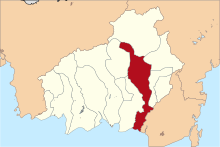 |
| 62.04 | South Barito Regency (Barito Selatan) |
6,267.1 | 108,560 | 124,128 | 131,140 | 134,698 | Buntok | 0.710 (High) |  |
| 62.05 | North Barito Regency (Barito Utara) |
10,152.25 | 109,273 | 121,573 | 154,812 | 160,605 | Muara Teweh | 0.712 (High) |  |
| 62.08 | Sukamara Regency | 3,311.2 | 29,561 | 44,952 | 63,464 | 66,633 | Sukamara | 0.689 (Medium) |  |
| 62.09 | Lamandau Regency | 7,673.56 | 47,969 | 63,199 | 97,611 | 102,103 | Nanga Bulik | 0.711 (High) | 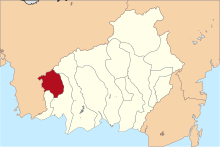 |
| 62.07 | Seruyan Regency | 15,215.2 | 92,037 | 139,931 | 162,906 | 171,304 | Kuala Pembuang | 0.682 (Medium) | 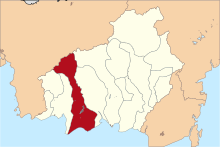 |
| 62.06 | Katingan Regency | 20,382.53 | 121,047 | 146,439 | 162,222 | 169,355 | Kasongan | 0.697 (Medium) | 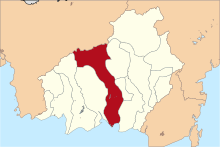 |
| 62.11 | Pulang Pisau Regency | 9,650.86 | 111,488 | 120,062 | 134,499 | 138,199 | Pulang Pisau | 0.690 (Medium) |  |
| 62.10 | Gunung Mas Regency | 9,305.8 | 74,823 | 96,990 | 135,373 | 142,835 | Kuala Kurun | 0.714 (High) |  |
| 62.13 | East Barito Regency (Barito Timur) |
3,212.5 | 71,907 | 97,372 | 113,229 | 117,312 | Tamiang Layang | 0.721 (High) |  |
| 62.10 | Murung Raya Regency | 23,575.3 | 74,050 | 96,857 | 111,527 | 116,621 | Purukcahu | 0.686 (Medium) | 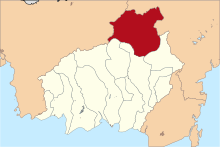 |
| 62.71 | Palangkaraya City | 2,848.7 | 158,770 | 220,962 | 293,457 | 305,797 | Palangkaraya | 0.812 (Very High) |  |
| Totals | 153,443.91 | 1,801,965 | 2,212,089 | 2,669,969 | 2,773,747 | Palangka Raya | 0.716 (High) |
In addition to the civil service, Central Kalimantan also recognises a traditional governing system led by traditional leaders known as Damang. The province is divided into 67 traditional law areas known as Kedamangan, headed by Damang. The system is intended to culturally recognise and preserve the customs and heritage of the Dayak tribes.[16]
The province now forms one of Indonesia's 84 national electoral districts to elect members to the People's Representative Council. The Central Kalimantan Electoral District consists of all of the 13 regencies in the province, together with the city of Palangkaraya, and elects 6 members to the People's Representative Council.[17]
Railroads
[edit]This section needs to be updated. (February 2021) |
A Russian company had been contracted to build railroads from Central Kalimantan to East Kalimantan for coal transportation, with an estimated cost of US$2.4 billion, that was expected to start in 2013 and be completed by 2017.[18]
Demographics
[edit]Population
[edit]| Year | Pop. | ±% |
|---|---|---|
| 1971 | 701,936 | — |
| 1980 | 954,353 | +36.0% |
| 1990 | 1,396,486 | +46.3% |
| 1995 | 1,627,453 | +16.5% |
| 2000 | 1,857,000 | +14.1% |
| 2005 | 1,914,900 | +3.1% |
| 2010 | 2,207,367 | +15.3% |
| 2015 | 2,490,178 | +12.8% |
| 2020 | 2,669,969 | +7.2% |
| 2023 | 2,773,747 | +3.9% |
| Source: Badan Pusat Statistik 2024[19] | ||
The total population of Central Kalimantan was 2,669,969 people based upon the national census in 2020; the official estimate as at mid 2023 was 2,773,747. The sex ratio of this province is 107 which means there are 107 males to every 100 females. The population density of Central Kalimantan is only 18 people/km2.[20]
Religion
[edit]Religion in Central Kalimantan (2022)[21]
According to the Statistics on 2021, the largest religious group in Central Kalimantan province is Islam with more than 74% of its total population. Then, the second largest group is Christianity with more than 19% of its total population. The rest of the population adhere to the local belief of Kaharingan, Hinduism, and Buddhism with more than 5%.[22][4][5]
- Religious Buildings in Central Kalimantan
-
Darussalam Grand Mosque in Palangka Raya
-
Balai Basarah Induk Intan in Muara Teweh (Kaharingan temple)
-
Kalimantan Evangelical Church in East Barito
-
Buddhist temple with Chinese architecture in Palangka Raya
Ethnic groups
[edit]Central Kalimantan is predominantly inhabited by the Dayak people that would further be divided into three major Dayak sub-ethnics. The three major Dayak tribes in Central Kalimantan are the Ngaju, Ot Danum and Dusun Ma'anyan Ot Siang. The three major tribes extended into several branches of prominent Dayak tribes in Central Kalimantan such as Lawangan, Taboyan, Dusun Siang, Boyan, Bantian, Dohoi and Kadori.
In addition to the indigenous Dayak tribes, there are also ethnic groups from other areas of Indonesia, including Malays, Javanese, Madurese, Batak, Toraja, Ambonese, Bugis, Palembang, Minang, Banjarese, Makassar, Papuan, Balinese, Acehnese and also Chinese.
| Ethnic group | Islam | Christian | Hindu | Other | % of population |
|---|---|---|---|---|---|
| Banjarese | 100% | 0% | 0% | 0% | 24.6% |
| Javanese | 96% | 4% | 0% | 0% | 18.8% |
| Ngaju Dayak | 43% | 44% | 13% | 0% | 18.0% |
| Sampit Dayak | 82% | 9% | 9% | 0% | 9.6% |
| Bakumpai | 99% | 0% | 0% | 0% | 7.5% |
| Madurese | 100% | 0% | 0% | 0% | 3.5% |
| Katingan Dayak | 37% | 22% | 32% | 9% | 3.3% |
| Maanyan | 4% | 86% | 9% | 1% | 2.8% |
| Tomun Dayak | 18% | 56% | 17% | 2% | 2.2% |
| Sundanese | 99% | 1% | 0% | 0% | 1.4% |
| Dusun Dayak | 9% | 29% | 63% | 0% | 1.1% |
| Siang Dayak | 6% | 40% | 48% | 4% | 0.9% |
| Manyan Dayak | 20% | 70% | 10% | 0% | 0.7% |
| Ot Danum | 10% | 51% | 38% | 0% | 0.6% |
| Other non-Dayak | NA | NA | NA | NA | 1.3% |
| Other Dayak | NA | NA | NA | NA | 5.0% |
Culture
[edit]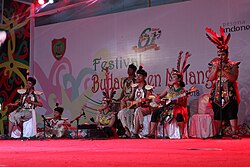
Traditional music
[edit]The most well-known traditional musical instrument from Central Kalimantan is Japen, Garantung, and Gandang Manca which are traditional Dayak musical instruments. These musical instruments are usually played during traditional procession or ritual.[25][26]
Japen or Kecapi is a lute-like instrument that is honored by Dayak people. This traditional musical instrument is usually played as an accompaniment for Central Kalimantan traditional music such as Karungut recitation, a Dayak oral literature in the form of musicalized rhyme scheme. Japen is mainly made of wood and nylon rope for its strings.[27][28]
Garantung is a percussion instrument that is fairly similar with kempul in gamelan. It is a type of hanging gong that is normally played ensembly with Gandang Manca or Gandang Kembar. Gandang Manca itself is a two-headed drum of Dayak traditional musical instrument that is mainly made of wood for the body of the drum and leather membranes to cover the cavity at both ends that are tied by rattan rope.[26] Both Garantung and Gandang Manca are commonly played ensembly as an accompaniment for Dayak traditional processions and rituals.[29]
Traditional architecture
[edit]The most notable fine arts of Dayak people is the traditional house. The traditional house of Dayak people in Central Kalimantan is commonly called Huma Betang. Huma Betang or simply called Betang like many other traditional houses in Indonesia is built on stilts. This traditional house structure is mainly made of iron wood which is commonly anti-termite and resistant to high humidity, thus the house can stand up to hundreds of years. Huma Betang is very well-known for its huge and long size. The length of this house structure is usually between 30 and 150 metres, the width is somewhere between 5 and 30 metres, and the height is approximately 3 to 6 metres. Due to its huge and long size, this house can be occupied by up to 150 people and usually inhabited by one big family.[30]
- Huma Betang Structures
-
A Huma Betang in Sei Pasah Village, Kapuas Regency, Central Kalimantan
-
A Huma Betang in Lewu Hante Museum, East Barito, Central Kalimantan
-
A Huma Betang with Sapundu sculpture at the front of the house in West Kotawaringin, Central Kalimantan
Traditional carving
[edit]

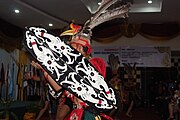
Central Kalimantan is well-known for its unique traditional carving. The three most famous carving from this province are the three dimensional wood carving sculpture of Sapundu and the traditional weapons i.e. Mandau and Talawang.
Sapundu sculpture is a three dimensional wood carving in the form of humanoid statue. This sculpture is commonly adorned with decorative motifs or even colors. Sapundu sculpture is mainly made of Bornean iron wood and usually presents during Tiwah procession. In ancient times, Sapundu sculpture symbolized the social status of its owner and was believed to possess magical powers.[31]
The Mandau and Talawang are the main traditional weapon of Dayak people in Central Kalimantan. The Mandau is a type of sword with a single edge blade i.e. one side is convex and the other side is concave. The Mandau consists of three different parts, which are (i) the Bilah or the blade that made of Mantikei iron plate with a sharp edge and is 70 cm long, (ii) the Pulang Gagang or the hilt that is usually made of wood, deer's horns, or even human bones, and (iii) the Sarung or the sheath which covers the blade and is typically made of wood and usually covered with bracelet-shaped bone on the upper part and wrapped by rattan rope.[32]
The Talawang is a shield that mainly made of Bornean iron wood that is carved with certain motifs and adorned with some bright colors. In ancient times, this weapon was used as a protection against wild animals and enemy's arrows and sword slashes. However, the function currently shifts to become a decorative ornament of Kaharingan temples, public buildings, or even people's houses mostly in Central Kalimantan.[33]
Traditional dance
[edit]Central Kalimantan is home for various sub-ethnics of Dayak tribe. Each of those Dayak sub-ethnics live spread out across all regencies in Central Kalimantan. This makes every regency have their own unique traditional dances. These are some of the traditional dances from Central Kalimantan:[34]
- Kinyah Mandau Hatue Dance, originating from Kapuas Regency and depicting theatrical war and martial arts of Dayak tribes in ancient time.[35]
- Giring-Giring Dance, coming from East Barito Regency and usually performed in group of 6 to 10 people.[36]
- Walian Dadas Dance, originating from South Barito Regency and used to be performed as a way to heal a region from negativity.[37]
- Babukung Dance, originally from Lamandau Regency and performed during funeral especially among Dayak Tomun people.[38]
- Tambun Bungai Dance, originating from Palangka Raya city and depicting heroic action of Tambung and Bungai protecting the territory from enemy who tried to loot people's crops.[39]
See also
[edit]References
[edit]- ^ a b c Badan Pusat Statistik, Jakarta, 28 February 2024, Provinsi Kalimantan Tengah Dalam Angka 2024 (Katalog-BPS 1102001.62)
- ^ Leo Suryadinata; Evi Nurvidya Arifin; Aris Ananta (2003). Indonesia's Population: Ethnicity and Religion in a Changing Political Landscape. Singapore: Institute of Southeast Asian Studies.
- ^ Aris Ananta; Evi Nurvidya Arifin; M. Sairi Hasbullah; Nur Budi Handayani; Agus Pramono (2015). Demography of Indonesia's Ethnicity. Singapore: Institute of Southeast Asian Studies.
- ^ a b c BPS Provinsi Kalimantan Tengah/BPS-Statistics of Kalimantan Tengah Province. Provinsi Kalimantan Tengah Dalam Angka 2018/Kalimantan Tengah Province in Figures 2018 (in Indonesian and English). BPS Provinsi Kalimantan Tengah/BPS-Statistics of Kalimantan Tengah Province. Retrieved 13 September 2018 – via BPS Kalimantan Tengah.
- ^ a b "Visualisasi Data Kependuduakan - Kementerian Dalam Negeri 2020". www.dukcapil.kemendagri.go.id. Retrieved 16 April 2021.
- ^ Badan Pusat Statistik (2023). "Produk Domestik Regional Bruto (Milyar Rupiah), 2022" (in Indonesian). Jakarta: Badan Pusat Statistik.
- ^ Badan Pusat Statistik (2023). "Produk Domestik Regional Bruto Per Kapita (Ribu Rupiah), 2022" (in Indonesian). Jakarta: Badan Pusat Statistik.
- ^ Badan Pembangunan Nasional (2023). "Capaian Indikator Utama Pembangunan" (in Indonesian). Jakarta: Badan Pembangunan Nasional.
- ^ "Indeks Pembangunan Manusia 2024" (in Indonesian). Statistics Indonesia. 2024. Retrieved 15 November 2024.
- ^ a b Biro Pusat Statistik, Jakarta, 2011.
- ^ a b Badan Pusat Statistik, Jakarta, 2021.
- ^ Profile Central Kalimantan Province. Central Kalimantan Province Tourism and Culture Board. September 2001.
- ^ Riwut, Nila; et al. (2003). Maneser Panatau Tatu Huang. Palangkaraya: Pusaka Lima. ISBN 979-97999-1-0.
- ^ a b "Informasi Kinerja Lingkungan Hidup Tahun 2019" (PDF) (in Indonesian). Environmental Services of Central Kalimantan. 2020. Retrieved 17 May 2023.
- ^ "Berita Resmi Statistik Kalimantan Tengah" (PDF). BPS Provinsi Kalimantan Tengah (in Indonesian). p. 45.
- ^ "PERDA Prov. Kalimantan Tengah No. 16 Tahun 2008 (Regional Regulation of Central Kalimantan Province No. 16 Of 2008)" (in Indonesian). Provincial Government of Central Kalimantan. December 2008. Retrieved 8 August 2023.
- ^ Law No. 7/2017 (UU No. 7 Tahun 2017) as amended by Government Regulation in Lieu of Law No. 1/2022 and Regulation of General Elections Commission No. 6/2023.
- ^ "Russian Firm Signs MoU to Build $2.4 Billion Railway". The Jakarta Post. February 8, 2012.
- ^ "Population Statistics of Central Kalimantan" (in Indonesian). July 2023. Retrieved 15 August 2023.
- ^ "Potret Sensus Penduduk 2020 Menuju Satu Data Kependudukan Indonesia Provinsi Kalimantan Tengah" (in Indonesian). April 2021. Retrieved 15 May 2023.
- ^ "Jumlah Penduduk Menurut Agama" (in Indonesian). Ministry of Religious Affairs. 31 August 2022. Retrieved 29 October 2023.
- ^ "Provinsi Kalimantan Tengah dalam Angka 2021" (in Indonesian). Badan Pusat Statistik of Central Kalimantan. February 2021. p. 357. Archived from the original on 2021-04-16. Retrieved 20 October 2021.
- ^ Aris Ananta; Evi Nurvidya Arifin; M. Sairi Hasbullah; Nur Budi Handayani; Agus Pramono (2015). Demography of Indonesia's Ethnicity. Institute of Southeast Asian Studies dan BPS – Statistics Indonesia.
- ^ Chalmers, Ian (2006). "The Dynamics of Conversion: The Islamisation of the Dayak Peoples of Central Kalimantan". In Vickers, A.; Hanlon, M. (eds.). Proceedings of the 16th Biennial Conference of the Asian Studies Association of Australia (ASAA): Asia Reconstructed, Jun 26–29 2006. Wollongong, NSW: Australian National University. hdl:20.500.11937/35283. ISBN 9780958083737.
- ^ "Japen & Garantung Alat Musik daerah Kalteng" (in Indonesian). Retrieved 16 May 2023.
- ^ a b "Alat Musik Gandang Manca" (in Indonesian). Pemkab Gunung Mas. Retrieved 16 May 2023.
- ^ "Materi Musik Nusantara" (PDF) (in Indonesian). UNY. Retrieved 1 May 2023.
- ^ "Kecapi, Alat Musik Tradisional Kalteng" (in Indonesian). Palangka Raya University. Retrieved 15 May 2023.
- ^ "Ensambel Sakepeng" (PDF) (in Indonesian). ISI Yogyakarta. 2020. Retrieved 17 May 2023.
- ^ "Huma Betang Masyarakat Dayak Kalimantan tengah" (in Indonesian). Centre of Language and Culture Studies in Surakarta. Retrieved 17 May 2023.
- ^ "Warisan Budaya Tak Benda Patung Sapundu" (in Indonesian). Ministry of Education, Culture, Research, and Technology (Indonesia). January 2015. Retrieved 17 May 2023.
- ^ "Warisan Budaya Tak Benda Mandau" (in Indonesian). Ministry of Education, Culture, Research, and Technology (Indonesia). January 2010. Retrieved 17 May 2023.
- ^ "Pergeseran Nilai Guna Talawang, Perisai Suku Dayak" (in Indonesian). May 2021. Retrieved 17 May 2023.
- ^ "Tarian Tradisional Asal Kalteng" (in Indonesian). Retrieved 16 May 2023.
- ^ "Makna Tarian Kinyah Mandau Hatue" (PDF) (in Indonesian). Airlangga University. Retrieved 17 May 2023.
- ^ "Deskripsi Tarian Giring-giring" (PDF) (in Indonesian). Ministry of Education, Culture, Research, and Technology (Indonesia). Retrieved 17 May 2023.
- ^ "Tarian Dadas dalam Membentuk Kedisiplinan" (in Indonesian). Palangka Raya University. Retrieved 17 May 2023.
- ^ "Tarian babukung Upacara Adat Pemakaman Suku Dayak Tomun" (in Indonesian). Kumparan. Retrieved 17 May 2023.
- ^ "Tari Tambun Bungai" (in Indonesian). Retrieved 17 May 2023.
External links
[edit]- Official website (in Indonesian)
- Official statistics for the province provided by Statistics Indonesia may be accessed (in Indonesian) at BPS-Statistics of Kalimantan Tengah Province.










